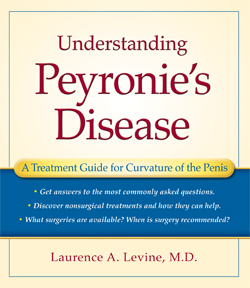 REVIEW
REVIEW
Library Journal
Levine, Laurence A., M.D.
Understanding Peyronie’s Disease: A Treatment Guide for Curvature of the Penis.
Addlcus. Sept. 2007.
c.160p. index. ISBN 978-1-886039-85-8.
pap. $16.95.
HEALTH
Peyronie’s disease is often diagnosed by the presence of excess scar tissue on the penis, often the result of injury or inflammation; it may affect the sexual function of about ten percent of men. Board-certified urologis Levine has edited his comprehensive professional text Peyronie’s Disease: A Guide to Clinical Management (Humana Pr., 2006) into a Q&A format for lay readers. The initial third presents an overview of the disease (including psychological aspects), and then the book segues into evenly divided sections on nonsurgical and surgical treatments. Most current treatments have undergone clinical trials of varying validity; some are severely questioned (e.g.. Vitamin E and the delivery of drugs by electric current), and others (e.g., hyperthermia) are not mentioned.
The author claims spontaneous remission in ten percent of cases; an authoritative text this reviewer consulted states 5o percent. Other drawbacks include the lack of Q&As on coping skills and partner relations and a barely adequate glossary. That said, this guide is readable and concisely written and would serve as a good discussion starter with health-care providers. Recommended for public and consumer health libraries.
—Janice Flafiff, Univ. of Toledo Health Science Ctr. Lib
REVIEW
Consumer Connection
Understanding Peyronie’s Disease: A Treatment Guide for Curvature of the Penis
Laurence A. Levine, MD
Addicus Books 978-1-886039-85-8 – $19.96
Understanding Peyronie’s Disease: A Treatment Guide for Curvature of the Penis, offers, in a Q&A format, frank discussion about a topic were trusted information written explicitly for the consumer may be hard to find. The author discusses many of the topics that men, and their partners, will have about what are potential contributing factors such as masturbation, jelquing, STDs, stress and others. Many of these topics may not surface in a doctor’s office due to embarrassment on the part of the patient or the physician. While girls and women have long been educated about their bodies, men still seem to find such education and discussion difficult, even with clinicians. Understanding Peyronie’s Disease may help patients formulate the questions they need to discuss with their health care provider.
PD, known as a “wound-healing disorder,” that is, is often instigated by the healing of a wound, in this case most often caused by some trauma (the most common trauma occurs during sexual intercourse).While there is no clear cause of PD, it does tend to run in families and there is “also likely some underlying genetic abnormality that predisposes a man to be unable to heal injuries to the penis in a normal fashion.” “Current thinking is that Peyronie’s disease develops most commonly following trauma to the erect penis during sexual activity.” While PDs onset may be rapid or quite slow, the first signs are often pain in the glans, or head of the penis, and the formation of a small nodule followed by further deformity, of which curvature is the most common. Because of the highly sensitive nature of PD “problems of depression, anxiety and loss of self-esteem … are now recognized to be quite common.” One of the primary issues causing emotional problems in PD patients is the shortening of the length of the penis of up to four inches.
Like many medical conditions PD is an equal opportunity disease, while it occurs mostly in middle-aged Caucasian men, it can occur in teenagers and the elderly and affect all ethnic groups (although this disparity could be a result of inequities in the health care system and Caucasians having greater access to medical care).
The author, Laurence Levine, M.D., a Rush University (Chicago, IL) physician and associate with the well known Urology Specialist in Chicago, opens the book with a detailed discussion about PD, its medical evaluation and sexual function. After obtaining a better understanding of the condition the author offers multiple chapters of both non-surgical and surgical treatments; glossary of terms and additional resources for those wanting further information. Levine provides a well organized and no-nonsense narrative that answers the questions that many are afraid to ask, and some that patients may not know they need to ask. This book is both informational and educational in tone and is highly recommended for all libraries— public, hospital, university, and consumer.
Reviewed by Howard Fuller, The Stupski Foundation, Mill Valley, CA
